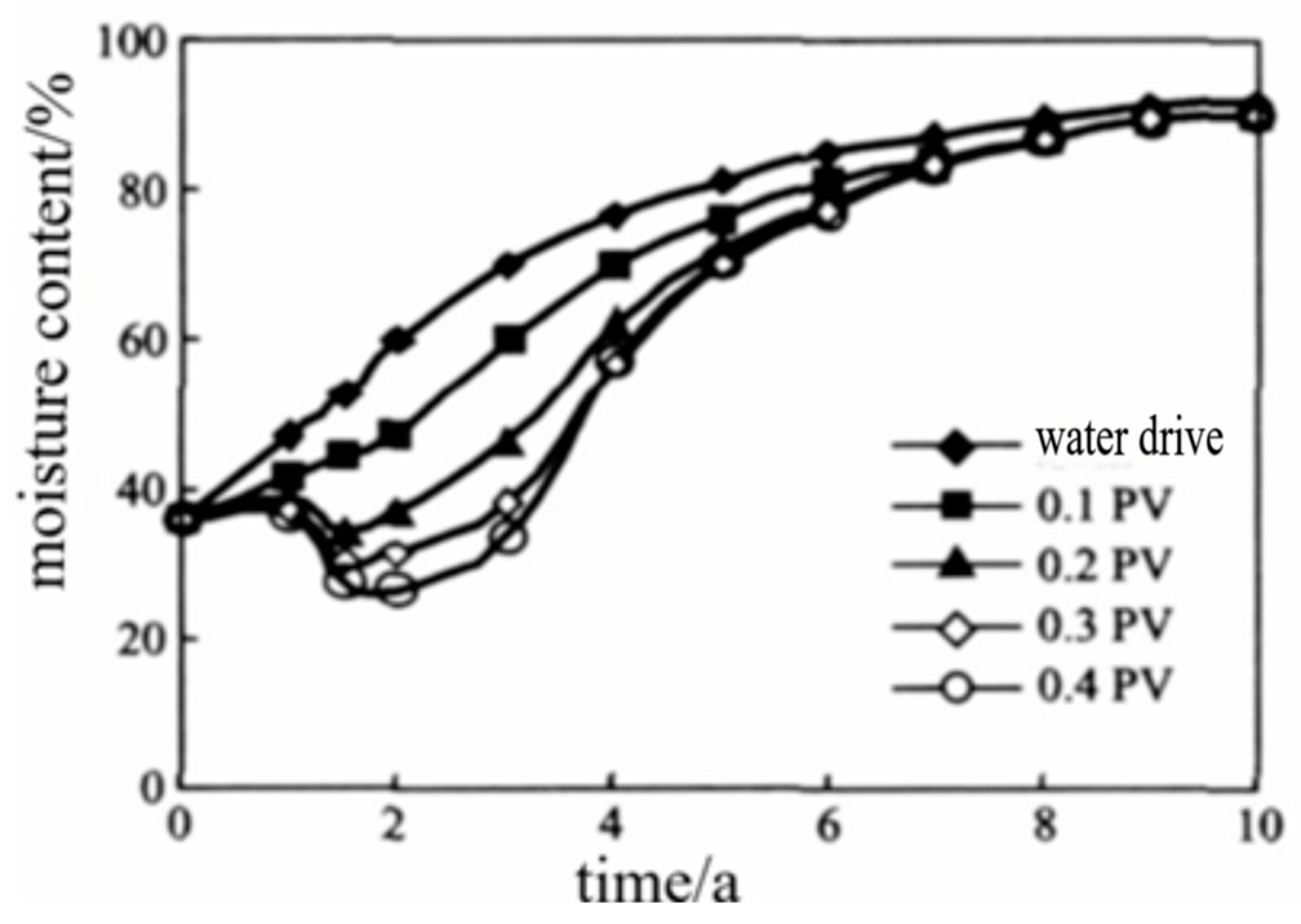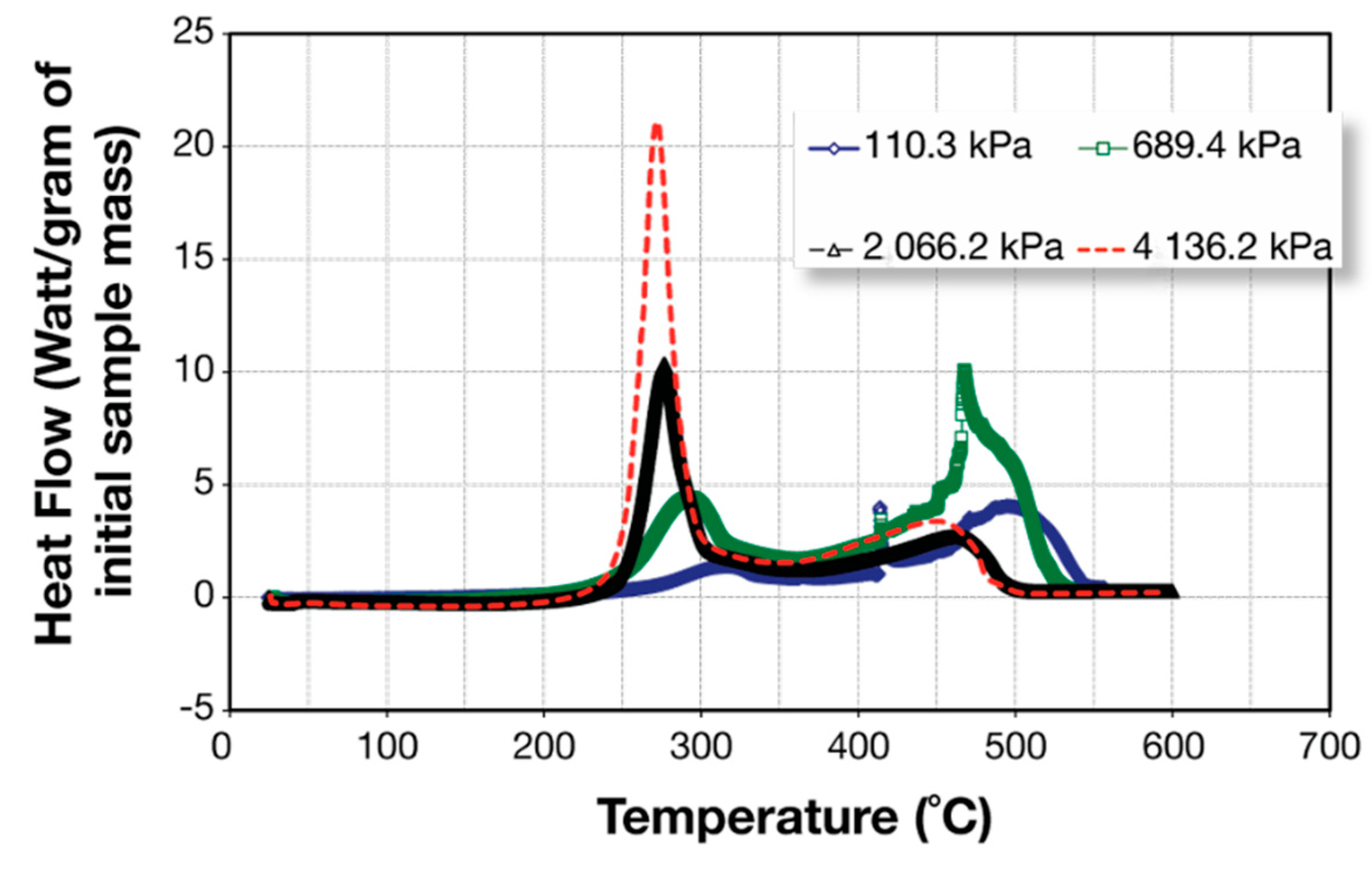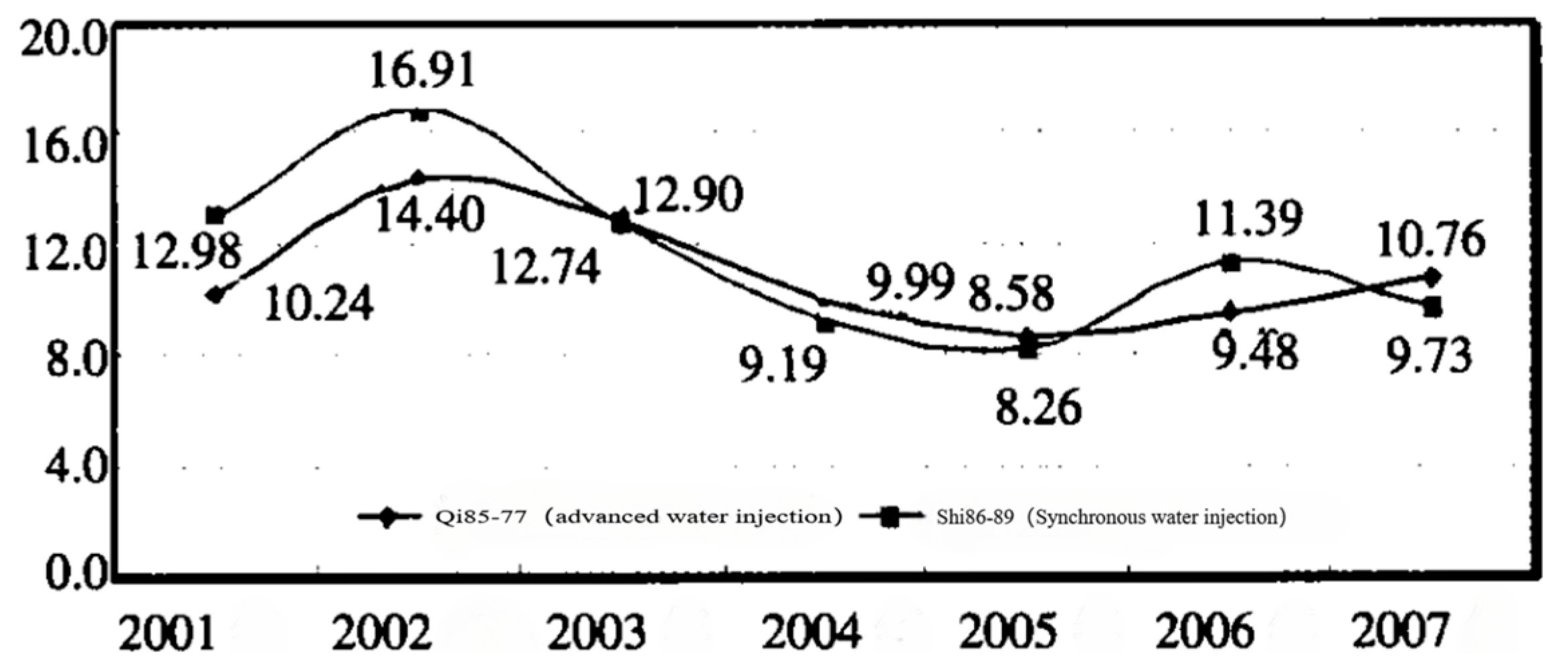Exploration and Application of Natural Gas Injection, Water Injection and Fracturing Technologies in Low-Permeability Reservoirs in China
Abstract
:1. Introduction
2. Gas Injection
2.1. Injecting CO2 for Oil Recovery
2.2. Nitrogen Injection for Oil Displacement
2.3. Air Oil Drive
2.4. Natural Gas Driven Oil Recovery
3. Water Injection for Oil Recovery
3.1. Unstable Water Injection for Oil Recovery
3.2. Advanced Water Injection
4. Water–Gas Alternation Oil Displacement
5. Fracturing Oil Displacement
5.1. Hydraulic Fracturing
5.2. Repeated Fracturing
6. Conclusions
Author Contributions
Funding
Data Availability Statement
Conflicts of Interest
References
- Qi, Q. Research on Oil Recovery Technology for Low Permeability Oilfield Reservoirs. Chem. Des. Commun. 2019, 45, 49+81. [Google Scholar]
- Jiang, H.; Li, Z.; Zhong, T.; Qi, R.; Li, Y. The status of low-permeability oil and gas development in the world. China Pet. Enterp. 2009, 9, 56–57. [Google Scholar]
- Qigui, C. Fine Description and Development Evaluation Technology for Low-Permeability Sandstone Reservoirs; Petroleum Industry Press: Beijing, China, 2010. [Google Scholar]
- Wenzhi, Z.; Caineng, Z. Resource potential and development prospects of low permeability oil and gas reservoirs in China. Pet. Explor. Dev. 2015, 42, 1–10. [Google Scholar]
- Weiwei, W. Research Status of Low Permeability Reservoir Evaluation. China Chem. Ind. Trade 2015, 17, 201. [Google Scholar]
- Dan, W. Research on Technical and Economic Evaluation of Low Permeability Reservoir Reserve Development Process. Xi’an Univ. Pet. 2012. [Google Scholar]
- Bing, L.; Zhiming, C.; Yutong, C. A review of research and development status of low-permeability reservoirs. Inn. Mong. Petrochem. Ind. 2013, 1, 123–125. [Google Scholar]
- Qing’, G. An Experimental Study on CO2 Oil Displacement in Songnan Gas Field. J. Pet. Nat. Gas 2010, 32, 130–132. [Google Scholar]
- Alvarado, V.; Manrique, E. Enhanced Oil Recovery: An Overview. J. Pet. Technol. 2010, 62, 56–63. [Google Scholar]
- Liu, R.; Liu, H.; Li, X.; Li, J.; Pang, C. Research on CO2 injection technology to enhance oil recovery in ultra-low permeability shallow reservoirs of Yanchang Oilfield. J. Xi’an Petr. Univ. 2010, 25, 63–65. [Google Scholar]
- Ruilan, L. Study on the adaptability of CO2 injection in heavy oil reservoirs. Petr. Drill. Prod. Technol. 2004, 26, 67–73. [Google Scholar]
- Qin, L. Application of CO2 Miscible Injection on Gao 89-1 Low Permeability Reservoir. In Proceedings of the SPE Asia Pacific Oil and Gas Conference and Exhibition, Jakarta, Indonesia, 20–22 September 2022. [Google Scholar]
- Kun, C.; Zhen, Y.; Yan, L.; Lu, Z.-Q.; Wu, S.-L.; Chen, Z.-H.; Huang, Z.-M. Method for Preparation of High Melt Strength Polypropylene with Long Branch Chain Structure by Supercritical Reaction Extrusion. Appl. Polym. Sci. 2011, 121, 3384–3392. [Google Scholar]
- Mapleston, P. Polyurethanes, polyolefin elastomers, debut for footwear applications. Mod. Plast. Int. 1997, 27, 122. [Google Scholar]
- Liu, P.; Zhou, L.; Feng, P.; Zhao, Z.; Li, J. Research on Nitrogen Injection in Wei 42 Ultra Low Permeability Oil Reservoirs. J. Jianghan Petr. Inst. 2001, 23, 58–60. [Google Scholar]
- Zhao, Y.; Hong, L.; Jiang, S.; Yue, X.; Wei, H. Analysis of nitrogen injection characteristics in oil reservoirs after water injection. Oilfield Chem. 2013, 30, 376–379. [Google Scholar]
- Bo, R. Numerical simulation study on nitrogen injection to enhance oil recovery in ultra-low permeability reservoirs in northern Shaanxi. Xi’an Univ. Pet. 2012, 14–21. [Google Scholar]
- Cao, X.; Guo, P.; Yang, X. Prospect analysis of gas injection to enhance oil recovery in low-permeability reservoirs. Nat. Gas Ind. 2006, 26, 100–102. [Google Scholar]
- Wang, J.; Zhang, Y.; Liu, S. Experimental study on low-temperature oxidation reaction of light oil. Spec. Oil Gas Reserv. 2012, 19, 116–121. [Google Scholar]
- Jiang, Y.; Xia, J.; Liu, S. Mechanism of air injection for oil recovery in low-permeability reservoirs. Pet. Explor. Dev. 2010, 37, 471–476. [Google Scholar]
- Li, J.; Mehta, S.A.; Moore, R.G. New Insights into Oxidation Behaviors of Crude Oils. J. Can. Pet. Technol 2009, 48, 18–22. [Google Scholar] [CrossRef]
- Sarma, H.; Shyamol, D. Air Injection Potential in Kenmore Oilfield: A Screening Study Through Thermogravimetric and Calorimetric Analyses. In Proceedings of the SPE Middle East Oil and Gas Show and Conference, Manama, Bahrain, 15 March 2009; p. SPE-120595-MS. [Google Scholar]
- Li, M.; Zhang, Y.; Liu, X. Research on Natural Gas Injection in Yushulin Oilfield, Daqing. Nat. Gas Ind. 2006, 26, 84–86. [Google Scholar]
- Xianqiang, L.; Anwei, Q.; Youlin, R. Exploration of Natural Gas Injection in Ultra-Low Permeability Residual Oil Reservoirs. In Proceedings of the 6th Youth Academic Conference of the Chinese Petroleum Society; Heilongjiang Science and Technology Press: Harbin, China, 2009. [Google Scholar]
- Zhao, Y.; Li, Q.; Chen, D. Study on the adaptability of natural gas injection in low-permeability reservoirs. Block Oil Gas Field 2009, 16, 77–79. [Google Scholar]
- Xuesong, L. Feasibility analysis and supporting process research of natural gas injection in Block 88. Xi’an Univ. Pet. 2007, 35–41. [Google Scholar]
- Xia, Y. Summer rain Application of nitrogen injection in foreign oil fields. Petr. Drill. Prod. Technol. 1995, 17, 65–70. [Google Scholar]
- Zong, L.; Jin, P.; Yang, K. High pressure nitrogen miscible/immiscible injection enhances oil recovery. For. Oilfield Eng. 2005, 21. ISSN 1002-641X. [Google Scholar]
- Willhite, G.P. Waterinjection: A Comprehensive Guide; Society of Petroleum Engineers: Richardson, TX, USA, 1986. [Google Scholar]
- Guohui, Z. Experimental study on unstable water injection in low-permeability reservoirs. West. Explor. Eng. 2022, 34, 105–107+118. [Google Scholar]
- Yang, X.; Xie, Y.; Zhang, J. How to improve oil recovery in the X1 reservoir of Wuliwan. Petrochem. Appl. 2024, 43, 47–49. [Google Scholar]
- Xu, H. Effective Water Injection Development Test for Rolling Outward Expansion of Low-grade Reservoir. J. Phys. Conf. Ser. 2023, 2503, 012016. [Google Scholar] [CrossRef]
- An, N. Research on Dynamic Productivity Characteristics and Technical Optimization of Advanced Water Injection in Triassic Oil Reservoirs. Chem. Manag. 2023, 3, 90–92. [Google Scholar]
- Bo, Z.; Avi, H. Research and application of advanced water injection technology in low-permeability oil fields. China Pet. Chem. Ind. Stand. Qual. 2021, 41, 169–170. [Google Scholar]
- Zhu, S.; Wang, W.; Mao, J. Quantitative Study on Advanced Water Injection Technology Policy for Ultra-Low Permeability Reservoirs in Wu 410 Area of Wuqi Oilfield. In Proceedings of the 6th Ningxia Young Scientists Forum; Ningxia Hui Autonomous Region Science and Technology Association: Ningxia, China, 2010. [Google Scholar]
- Daofu, W. Development of Ultra-Low Permeability Oil Fields in the Ordos Basin; Petroleum Industry Press: Beijing, China, 2007; Volume 3. [Google Scholar]
- Zhou, X.; Liao, X.; Zhao, X. Experimental study on CO2 water gas alternation injection in ultra-low permeability reservoirs. J. Shaanxi Univ. Sci. Technol. 2016, 34, 120–124. [Google Scholar]
- Yu, C.; Xia, Z.; Ren, W. Research on the law of CO 2 water gas alternation driving in ultra-low permeability reservoirs. Petrochem. Appl. 2023, 42, 37–41. [Google Scholar]
- Huang, R.; Tang, X.; Huang, X. Pilot Experimental Study on Water Gas Alternating Composite Injection for Enhanced Oil Recovery in Bohai a Oilfield. Petrochem. Appl. 2016, 35, 28–32. [Google Scholar]
- Skauge, A.; Aarra, M.G.; Surgucher, L. Foam-Assisted WAG: Experience form the Snorre Field. In Proceedings of the SPE/DOE Improved Oil Recovery Symposium, Tulsa, OK, USA, 13 April 2002; p. SPE-75157-MS. [Google Scholar]
- Liu, W.; Yao, J.; Chen, Z. Numerical simulation study on reverse nine-point hydraulic fracturing injection production well network in low-permeability reservoirs considering the influence of dynamic boundaries. Petrochem. Appl. 2014, 14, 170–175. [Google Scholar]
- Settari, A. A New General Model of Fluid Loss in Hydraulic Fracturing. Soc. Pet. Eng. J. 1985, 25, 491–501. [Google Scholar] [CrossRef]
- Clark, P.E.; Barkat, O. Analysis of Fluid-Loss Data. SPE Prod. Eng. 1990, 5, 306–310. [Google Scholar] [CrossRef]
- Zhou, F.; Mou, Y.; Song, R. Research on Optimization of Hydraulic Fracturing Scheme for Ultra Low Permeability Oil Reservoirs. In Proceedings of the Advanced Seminar on New Technologies for Oil and Gas Drilling and Production in China, China Petroleum Society; Petroleum Institute: Daqing, China, 2006. [Google Scholar]
- Jianli, F. Research on Hydraulic Fracturing Technology for the Shishen 100 Fault Block. Neijiang Sci. Technol. 2006, 27, 155–156. [Google Scholar]
- Sun, J.; Yang, M.; Dai, J. Research and application of repeated fracturing mechanism in low-permeability reservoirs. Inn. Mong. Petrochem. 2004, 30, 158–159. [Google Scholar]
- Dongxu, H. Research and Application of Infiltration Fluid for Repeated Fracturing of Low Permeability Tight Oil Reservoirs. Petr. Nat. Gas Chem. Ind. 2023, 52, 99–103+109. [Google Scholar]
- Xie, J.; Wang, C.; Yin, H.; Tang, X.; Han, H.; Luo, S.; Li, X. Research and application of repeated fracturing technology for old shale oil wells in Jimsar. Petr. Nat. Gas Chem. Ind. 2021, 50, 100–103. [Google Scholar]




| Technical Category | Specific Technology | Brief Characteristics |
|---|---|---|
| Gas Injection Technologies | Carbon Dioxide Injection | High recovery, corrosion, gas channeling |
| Gas Injection Technologies | Nitrogen Injection | Self-expansion, limited recovery, safe |
| Gas Injection Technologies | Air Injection | Oxidation reduces viscosity, oxygen issues, corrosion risk |
| Water Injection Technologies | Unstable Water Injection | Boosts recovery, unstable start |
| Water Injection Technologies | Advanced Water Injection | Reduces damage, timing issue |
| Integrated Technologies | Water–Gas Alternating Injection | Solves channeling, injection-switch problem |
| Fracturing Technologies | Hydraulic Fracturing | Increases production, pollution, cost, energy/time issues |
| Fracturing Technologies | Repeated Fracturing | Improve recovery, special reservoir limits |
| Advantage | Disadvantage | |
|---|---|---|
| Gas injection | Improve oil recovery efficiency | High cost |
| Water injection for oil recovery | Mature technology, low cost and wide applicability | Easy water channeling, high water quality |
| Fracturing oil displacement | Improve oil recovery efficiency | Groundwater pollution, high cost |
| Number | Size/cm | Diameter/10−3μm2 | Porosity/% | Oil Saturation/% | Injection Method | Recovery Efficiency/% | |||
|---|---|---|---|---|---|---|---|---|---|
| 1 | 8.8 | 2.5 | 2.67 | 12.69 | 62.5 | Gas driven oil after water injection | 47.15 | 50.01 | 2.86 |
| 2 | 10 | 2.5 | 1.07 | 18.94 | 62.46 | Gas water alternation after water injection | 44.83 | 61.20 | 16.37 |
| 3 | 10 | 2.5 | 1.65 | 13.51 | 51.53 | Pulse steam injection after water injection | 43.03 | 57.97 | 15.94 |
| Oil Displacement Method | Applicability | Advantages | Disadvantages |
|---|---|---|---|
| Inject CO2 to drive oil | Suitable for various reservoirs, especially those with high minimum miscible pressure. Immiscible injection has potential. | Reduces viscosity, enhances fluidity, and has high potential for increasing recovery. | Difficult to achieve miscibility, limited by safety and economy, corrosive, prone to gas channeling, high investment, small sweep coefficient. |
| Inject nitrogen to drive oil | Feasible for specific reservoirs (e.g., Mahu tight conglomerate reservoirs), suitable for reservoirs hard to achieve miscible injection. | Expands for oil displacement, relatively safe. | Limited increase in recovery, high minimum miscible pressure, hard to achieve miscibility in some blocks. |
| Inject air to drive oil | Injecting oxygen-containing air expands gas drive adaptability. | Wide gas source, low cost, can optimize parameters to reduce corrosion. | Corrosion risk, strict parameter control required. |
| Injecting natural gas to drive oil | Promising for low-permeability heavy oil reservoirs. | Significantly reduce viscosity, improve flowability, and increase recovery rate | Gas supply may be limited, safety risks exist. |
| Block | Reserves Abundance (104 t/km2) | Well- Pattern Density | Permeability ty (mD) | Valid Thickness s (m) | Water Injection Mode | Put into Production Mode | Well Pattern | Initial L Stage | Oil Recovery Strength (t/d.m) | Oil Recovery (%) |
|---|---|---|---|---|---|---|---|---|---|---|
| B2 | 58.3 | 14.5 | 11.9 | 6.5 | 6 months behind | Universal investment | 220 m triangle Reverse seven-point water injection well network | 3.5 | 0.54 | 1.05 |
| B3 | 39.4 | 13.1 | 2.6 | 5.4 | Synchrony us water injection | Universal investment | 300 m square Reverse nine-point water injection well network | 1.5 | 0.28 | 0.53 |
| B4 | 32.7 | 23 | 2.15 | 4.9 | Synchrony us water injection | Whole fracture | 300 m × 150/120 m Recta angle well pattern linear water injection | 1.6 | 0.33 | 1.49 |
Disclaimer/Publisher’s Note: The statements, opinions and data contained in all publications are solely those of the individual author(s) and contributor(s) and not of MDPI and/or the editor(s). MDPI and/or the editor(s) disclaim responsibility for any injury to people or property resulting from any ideas, methods, instructions or products referred to in the content. |
© 2025 by the authors. Licensee MDPI, Basel, Switzerland. This article is an open access article distributed under the terms and conditions of the Creative Commons Attribution (CC BY) license (https://creativecommons.org/licenses/by/4.0/).
Share and Cite
Zhao, X.; Qi, X. Exploration and Application of Natural Gas Injection, Water Injection and Fracturing Technologies in Low-Permeability Reservoirs in China. Processes 2025, 13, 855. https://doi.org/10.3390/pr13030855
Zhao X, Qi X. Exploration and Application of Natural Gas Injection, Water Injection and Fracturing Technologies in Low-Permeability Reservoirs in China. Processes. 2025; 13(3):855. https://doi.org/10.3390/pr13030855
Chicago/Turabian StyleZhao, Xiaoliang, and Xingyan Qi. 2025. "Exploration and Application of Natural Gas Injection, Water Injection and Fracturing Technologies in Low-Permeability Reservoirs in China" Processes 13, no. 3: 855. https://doi.org/10.3390/pr13030855
APA StyleZhao, X., & Qi, X. (2025). Exploration and Application of Natural Gas Injection, Water Injection and Fracturing Technologies in Low-Permeability Reservoirs in China. Processes, 13(3), 855. https://doi.org/10.3390/pr13030855





